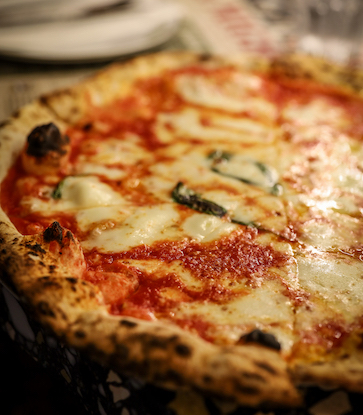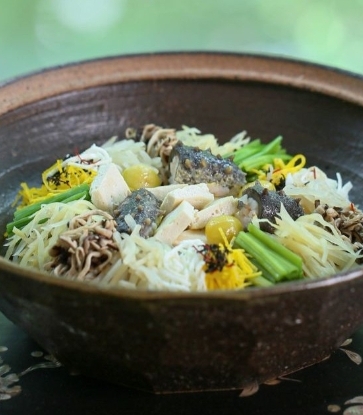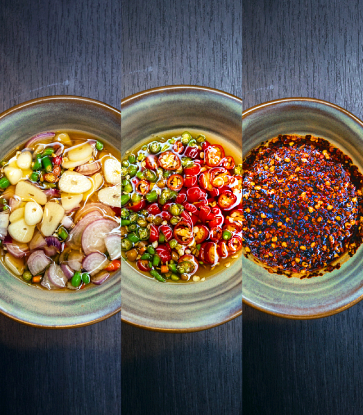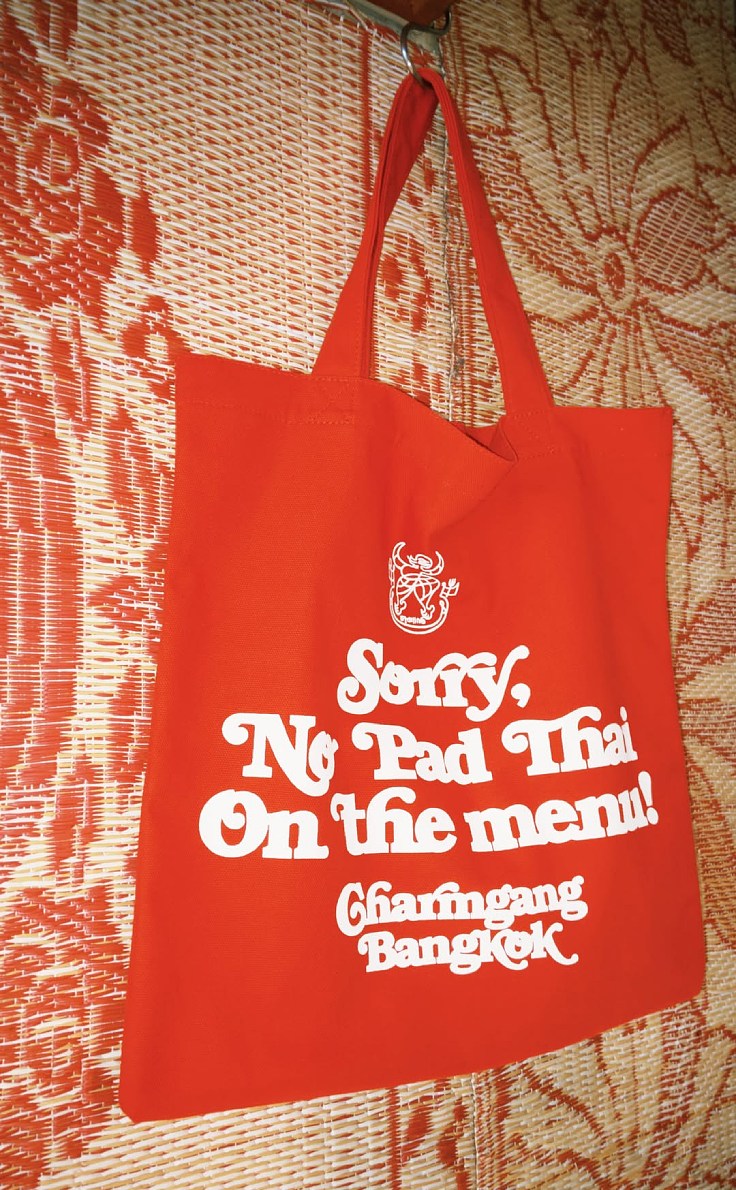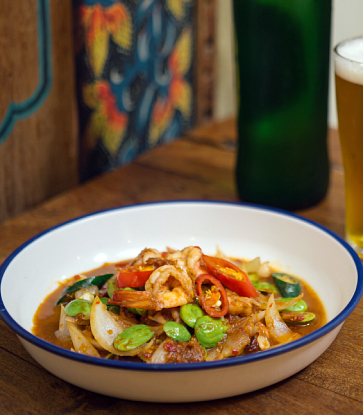It is difficult to imagine Thai cuisine without luscious, creamy coconut milk. We use it in various dishes such as curries, soups, dressings, stir-fries, dips, and desserts. Although coconut milk is not that crucial in Northern and Northeastern kitchens, this white liquid is very much essential to Central and Southern fares.
The MICHELIN Guide invites you, amateurs and experts alike, to explore the world of coconut milk. What are the differences between fresh and canned coconut milk, and how to use them? What are the secrets to making the best coconut milk-based dishes? Read on!

Working with fresh coconut milk
For those who have cooked with fresh coconut milk before, you know what we are talking about here. Fresh coconut milk can be quite the chore every step of the way from buying and bringing it home to cooking and storing properly for future use.However, if you have tried dishes made with fresh coconut milk, you know it’s worth all the time and effort.
Where can you buy fresh coconut milk? It’s best to head to your local fresh market. Yes, the one with no air-con. You can buy either grated coconut to squeeze for extra-fresh milk at home or fresh-squeezed coconut milk, which is sold by the kilogramme.
Treat yourself to a natural hand moisturiser by buying grated coconut flesh to squeeze yourself. Use cheesecloth or a colander. The first squeeze is the most concentrated coconut milk or coconut cream. One kilogramme of grated coconut usually yields around 300-400 grammes of milk. Add warm water and squeeze again for semi-concentrated milk. The third squeeze gives thin milk. Depending on your preference, you could use warm water for the first squeeze, but the result will not be as concentrated or creamy.
If that sounds like too much trouble, just buy the fresh-squeezed coconut milk. For newbies, however, it takes trial and error to find reliable coconut milk sellers. You need experience to be able to tell if the grated coconut is not fresh. Otherwise, you may later find the coconut milk spoiled or sour. There’s not much to do except to start your car and go buy a new batch or just head to your local supermarket for boxed or canned varieties.
There’s really no other way. You have to keep searching for that good, reliable coconut milk shop that will get your business for life.

Bringing fresh-squeezed coconut milk home and storing it is also a challenge as the milky liquid spoils easily. It is always best to use it right away, or keep it refrigerated if you are using it several hours later. Bringing the coconut milk to a gentle boil can help extend its shelf life. You will be sacrificing some natural sweetness, but still it would yield better flavour than using its boxed or canned cousins.
Cooking with coconut milk is both art and science. There is no way to perfectly explain all the processes through writing. You’ll have to see an expert at work to fully understand. Cooking with coconut milk requires patience and experience to control the heat to preserve the luscious sugariness and smooth texture. However, some cooks intentionally boil until the coconut milk “breaks” to obtain a unique texture for their curries. And that’s not wrong.
Asst. Prof. Sisamon Kongpan, a Thai food master and a multiple Thai cookbook author, has specified some characteristics of coconut milk-based dishes in her books. For example, a good pot of green curry starts from stir-frying the curry paste in some oil until fragrant. Then you gradually add the coconut cream and stir gently until aromatic and some traces of oil appear on top. The chicken goes in later.
It is recommended that you cook the chicken first in thin coconut milk until it is nice and tender. Do not use coconut cream, as it may congeal on the meat for a less than appetising appearance. The thin coconut milk should be moderately hot before putting in the raw chicken, otherwise there may be an unpleasant odour. It’s all about the details!
“Stir-frying the curry paste with some oil until fragrant”: that’s the tricky part. How do you know when it is fragrant enough and ready for the coconut milk? Well, the master Kongpan recommended observing the surface. Once little oil droplets float on top, add the coconut milk little by little. Avoid adding all at once or keep cooking until the coconut milk cracks and separates. Master Kongpan insists that a good cook must learn to taste and adjust for the flavour.
So, what are the “good characteristics” of some coconut milk-based dishes?
- Green curry with chicken: The curry should be a little thick, but not too creamy. The surface appears nice and glossy but not separated. The flavour should be spicy, with a sweet and fragrant hint from the coconut milk.
- Beef curry with bird’s eye chillies: The texture should be thicker than that of green curry, but with no oil on top. All flavours should be present.
- Beef panang: The curry should be thick but not so smooth, deep red in colour and with glossy surface. Panang is usually spicier than Chu-chi curry. All flavours should be dominant.
- Beef massaman curry: The curry should be moderately thick, with a layer of red oil on top. Flavour should be dominantly sweet but not too much. Massaman is usually not spicy.
- Red curry with chicken: There should be some traces of red oil on top, but not separated. This curry is often less spicy than green curry.
- Khua curry (a type of red curry): Reddish orange is the ideal colour, with moderate thickness and some spots of oil on top. All flavours are equally dominant.
- Chu-chi curry: There should be no traces of oil on top and have a moderate amount of curry. Chu-chi is thicker than red curry, and it is not spicy but dominantly sweet.
- Kanom Chin Nam Phrik (Fresh rice vermicelli with sweet and mild curry): The curry should be beautifully thick and never sticky with a glossy red surface.

These are the characteristics mentioned by the honorary expert, Kongpan. To actually master these techniques is, indeed, a challenge. Controlling the heat and not separating the luscious liquid while gradually adding the remaining coconut milk is already a task. For many of us, trying to make four different types of curry may produce four identical results.
If you are making a coconut milk-based soup like tom kha kai or its Southern variety, it is essential that the coconut milk doesn’t separate. The soup should be relatively smooth and not greasy.
In his book Thai Food, the internationally acclaimed David Thompson of One MICHELIN Starred Aaharn in Hong Kong shares many tips and tricks he has discovered. From how to choose the best coconut and break it with a cleaver and store the aromatic juice to how to grate the coconut meat with special tools.
He also advises that it’s best to keep fresh-squeezed coconut milk in a glass, porcelain, or plastic bowl, as stainless steel may distort the liquid’s quality. And letting the liquid sit for a length of time will separate cream and milk.
However, if you are to keep it refrigerated, he suggests adding a crushed chilli could delay any coagulation. And bringing the coconut milk to a soft boil before storing would be equivalent to a pasteurisation.
We hope that by now you have an idea about how to handle the precious and delicate coconut milk, as every cook has his or her own way according to how they were taught.
Freshly squeezed coconut milk may be tricky and must be handled with care, but we guarantee it yields more than satisfying results. Plus, it is a great experience for those who are serious about cooking Thai dishes.

Working with boxed or canned coconut milk
“Canned coconut cream has been pasteurised and homogenised and, as a result of the canning process and long storage, I believe, bastardised,” states Chef Thompson in his book. That’s enough to make you cringe when reaching for ready-to-use coconut milk in a supermarket.
Meanwhile a well-respected Thai chef, M.L. Kwantip Devakula, may be flexible when it comes to using a food processor to make curry paste instead of a traditional mortar. However, for recipes that call for coconut milk, she insists on squeezing grated coconut, according to her book published in June 2021.
Fortunately, these experts understand that this is not the easiest task for rookies. Below are the tips and tricks from Master Kongpan on cooking with ready-to-use coconut milk.
- Boxed and canned varieties often contain some flour to prevent the fat and water content from separating.
- The liquid is equivalent to coconut cream. So, if the recipe calls for coconut milk, mix ½ cup coconut cream with ½ cup water. For thin coconut milk, use ¼ cup coconut cream with ¾ cup water.
- Which brand is best? Here’s how you can test. Pour each into separate pots and bring them to a light boil. If the liquid thickens and has some oil on top, the amount of flour is comparatively high, and that brand wouldn’t create the ideal texture.
- If the coconut milk breaks into tiny particles and water, that signifies a comparatively low amount of flour used. However, more water also means less creaminess and sweetness.

Thailand is home to some of the most delicious coconuts in the world. So why not try cooking with fresh coconut milk? You may find it as amusing as Tom Daley’s skillful knitting with a delicious outcome as an added bonus. And you’ll appreciate the Thai cooks who came before without the conveniences we have today but who took the time to laboriously grate and squeeze coconuts by hand for a perfectly balanced Thai curry.
And it is all worth it.
This deliciously creamy liquid is also the backbone of several Thai dishes from traditional to contemporary ones. So don’t forget to give them a try, from khao man som tam (rice cooked in coconut milk), kaeng rawaeng, and dry tom kha to khao pad khiaw wan (stir fried rice with green curry condiments).

If all these are too complicated (we won’t blame you!), our MICHELIN Inspectors recommend One-MICHELIN-Starred Methavalai Sorndaeng’s kaeng khua pu cha-om (crab curry with acacia leaves) and Saneh Jaan’s kaeng Mon mu yang (Mon-style curry with grilled pork) and khao mao rang (old-fashioned Thai dessert using roasted young grains and coconut milk) for those in Bangkok.
For the Chiang Mai bound, pay Bib Gourmand awarded Han Thueng Chiang Mai, Khao Soi Mae Manee, or a MICHELIN Plate awarded Khao Soi Lamduan Faham a visit to devour their curry-based noodles and unmissable khao soi.
Heading South to Phuket and Phang-Nga? Do yourself a favour and enjoy the hot-yet-heavenly kaeng khua hoy khom (periwinkle curry) at Bib Gourmand recipient Naam Yoi, kaeng pu bai chaplu (crab curry with betel leaves) at Jadjan, and khanom chin at the MICHELIN Plate awarded Khanom Chin Pa Son.



